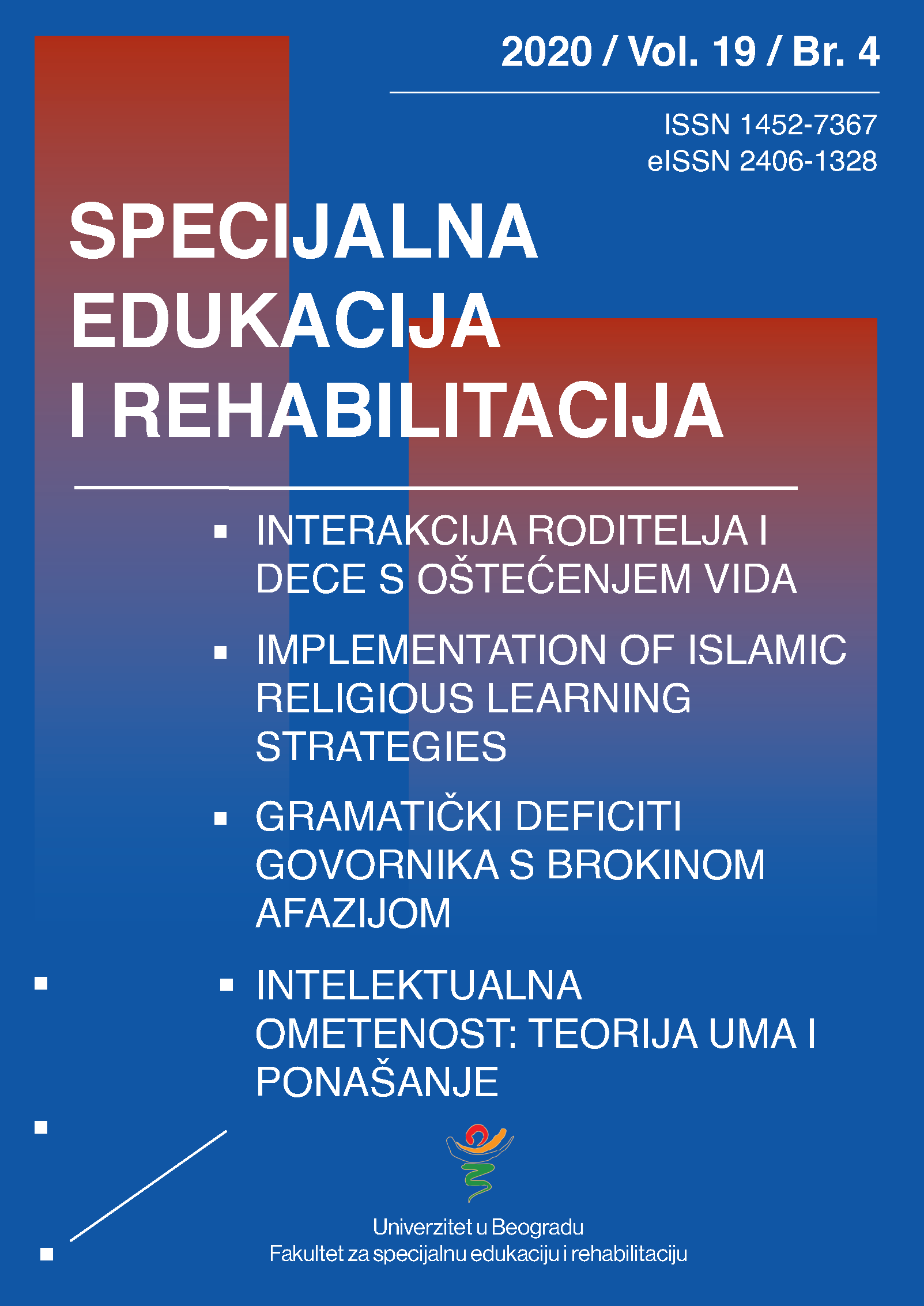Grammatical deficits of Serbian speakers with Broca’s aphasia: A preliminary investigation
Abstract
Introduction. Studies of language deficits in patients with Broca’s aphasia have highlighted agrammatism as a major feature. As the nature of this language deficit is still unknown, further data collection according to the specifics of the particular language is of great importance. Objective. In this paper, we wanted to determine grammatical deficits in Serbian speakers with aphasia. Methods. Using Boston Diagnostic Aphasia Examination, we determined Broca’s aphasia on a sample of 20 subjects, aged 47-70. Speech samples were obtained through two tasks: conversation and picture description. The analysis of samples involved determining the type and subtype of all words and their forms; determining the total number and types of clauses, as well as their functions in a given discourse. Also, the argument structure of the verb was identified. The primary and secondary sentence constituents were determined. Results. The results showed that nouns and full verbs dominate in the speech of patients with Broca’s aphasia. Nouns are most often used in the nominative case, and verbs in the present tense. The ability to use verbs is related to the complexity of their argument structure. Speech is dominated by short utterances whose full meaning is often difficult to determine. Conclusion. Our data show that almost all patients with Broca’s aphasia exhibit grammatical deficits. The general signs of agrammatism are similar to the signs described in other languages. We single out the difficulties in the use of clitics as a prominent characteristic of agrammatism in our respondents.
References
Bastiaanse, R., Hugen, J., Kos, M., & van Zonneveld, R. (2002). Lexical, morphological, and syntactic aspects of verb production in agrammatic aphasics. Brain and Language, 80(2), 142-159. https://doi.org/10.1006/brln.2001.2585
Bastiaanse, R., & Thompson, C. (2003). Verb and auxiliary movement in agrammatic Broca’s aphasia. Brain and Language, 84(2), 286-305. https://doi.org/10.1016/s0093-934x(02)00553-9
Bates, E. A., Friedersici, A. D., Wulfeck, B. B., & Juarez, L. A. (1988). On the preservation of word order in aphasia: Cross-linguistic evidence. Brain and Language, 33(2), 323-364. https://doi.org/10.1016/0093-934X(88)90072-7
Den Ouden, D. B., & Bastiaanse, R. (2009). The electrophysiological manifestation of Dutch Verb Second violations. Journal of Psycholinguistic Research, 38(3), 201-219. https://doi.org/10.1007/s10936-009-9106-6
Den Ouden, D. B., Fix, S., Parrish, T. B., & Thompson, C. K. (2009). Argument structure effects in action verb naming in static and dynamic conditions. Journal of Neurolinguistics, 22(2), 196-215. https://doi.org/10.1016/j.jneuroling.2008.10.004
Den Ouden, D. B., Malyutina, S., Basilakos, A., Bonilha, L., Gleichgerrcht, E., Yourganov, G., Hillis, A. E., Hickok, G., Rorden, C., & Fridriksson, J. (2019). Cortical and structural-connectivity damage correlated with impaired syntactic processing in aphasia. Human Brain Mapping, 40(7), 2153-2173. https://doi.org/10.1002/hbm.24514
Friedmann, N. (2001). Agrammatism and the psychological reality of the syntactic tree. Journal of Psycholinguistic Research, 30(1), 71-90. https://doi.org/10.1023/A:1005256224207
Friedmann, N. (2005). Degrees of severity and recovery in agrammatism: Climbing up the syntactic tree. Aphasiology, 19(10-11), 1037-1051. https://doi.org/10.1080/02687030544000236
Goodglass, H., & Kaplan, E. (1983). The assessment of aphasia and related disorders. Lea & Febiger.
Greenlee, J. D. W., Oya, H., Kawasaki, H., Volkov, I. O., Severson, A. M., Howard M. A., & Brugge, J. F. (2007). Functional connections within the human inferior frontal gyrus. The Journal of Comparative Neurology, 503(4), 550-559. https://doi.org/10.1002/cne.21405
Kašić, Z., i Borota, V. (2003). Negramatičnost i agramatizam u aktivnom sintaksičkom razvoju. Srpski jezik – studije srpske i slovenske, 8(1-2), 439-455.
Kearns, K. P. (1997). Broca’s aphasia. In L. L. LaPointe (Ed.), Aphasia and related neurogenic language disorders (pp. 1-41). Thieme.
Kegl, J. (1995). Levels of representation and units of access relevant to agrammatism. Brain and Language, 50(2), 151-200. https://doi.org/10.1006/brln.1995.1044
Kim, M., & Thompson, C. K. (2000). Patterns of comprehension and production of nouns and verbs in agrammatism: Implications for lexical organization. Brain and Language, 74(1), 1-25. https://doi.org/10.1006/brln.2000.2315
Lee, M., & Thompson, C. K. (2004). Agrammatic aphasic production and comprehension of unaccusative verbs in sentence contexts. Journal of Neurolinguistics, 17(4), 315-330. https://doi.org/10.1016/S0911-6044(03)00062-9
Levin, B., & Rappaport Hovav, M. (1995). Unaccusativity: At the syntax-lexical semantics interface. MIT Press.
Lindenberg, R., Fangerau, H., & Seitz, R. J. (2007). “Broca’s area” as a collective term? Brain and Language, 102(1), 22-29. https://doi.org/10.1016/j.bandl.2006.11.012
Ruingedijk, E., Kouwenberg, M., & Friedmann, N. (2004). Question production in Dutch agrammatism. Brain and Language, 91(1), 116-117. https://doi.org/10.1016/j.bandl.2004.06.060
Stanojčić, Ž., i Popović, LJ. (1994). Gramatika srpskoga jezika. Zavod za udžbenike i nastavna sredstva.
Thompson, C. K. (2003). Unaccusative verb production in agrammatic aphasia: The argument structure complexity hypothesis. Journal of Neurolinguistics, 16(2-3), 151-167. https://doi.org/10.1016/S0911-6044(02)00014-3
Thompson, C. K. (2019). Neurocognitive recovery of sentence processing in aphasia. Journal of Speech, Language, and Hearing Research, 62(11), 3947-3972. https://doi.org/10.1044/2019_JSLHR-L-RSNP-19-0219
Thompson, C. K., Lange, K. L., Schneider, S. L., & Shapiro, L. P. (1997). Agrammatic and non-brain-damaged subjects’ verb and verb argument structure production. Aphasiology, 11(4), 473-490. https://doi.org/10.1080/02687039708248485
Vuković, M. (2002). Afaziologija. SD Publik.
Vuković, M. (2016). Afaziologija (Četvrto dopunjeno izdanje). Udruženje logopeda Srbije.
Vuković, M. (2019). Tretman afazija (Treće dopunjeno izdanje). M. Vuković.
Vuković, M., & Stojanovik, V. (2011). Characterizing developmental language impairment in Serbian-speaking children: A preliminary investigation. Clinical Linguistics & Phonetics, 25(3), 187-197. https://doi.org/10.3109/02699206.2010.521611
Copyright (c) 2021 Specijalna edukacija i rehabilitacija

This work is licensed under a Creative Commons Attribution-ShareAlike 4.0 International License.

